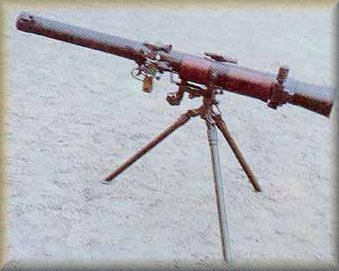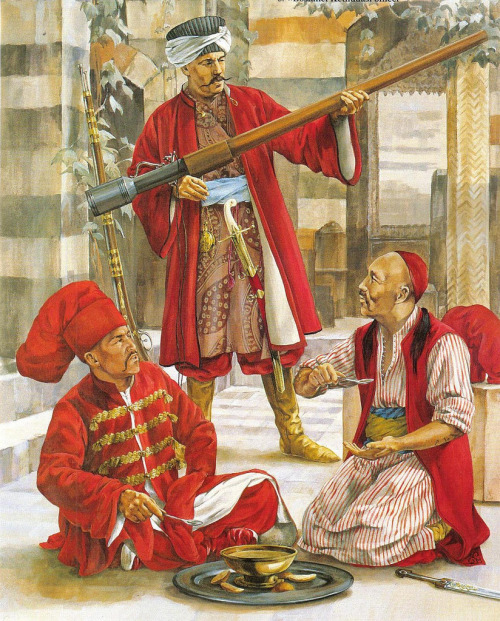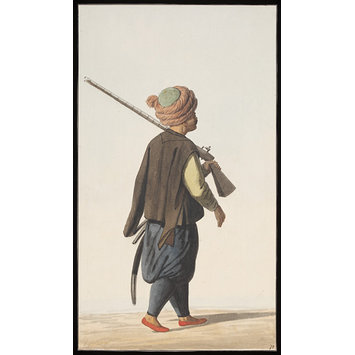
Originally Posted by
panzer 4

k Dee Jay has allowed me to use his notes, all credit goes to Dee Jay on these ones:
Here is my knowledge of the Ottoman Cavalry.
They fought very much like an irregular cavalry force, did not use tight formations, and fought in deep ranks. Also, the common weapon for all Ottoman cavalry was the lance, pretty much every horseman in the Ottoman Army (regualr and irregular) fought with the lance as their primary weapon.
REGULAR CAVALRY
So, the best of the Regular Cavalry were the Silahtar and Sipahi Oglans. These troops were considered as guard units by many and were well trained in the tactics, but like all Ottoman cavalry fought in their loose, deep, mod-like formations. They were only armed with a lance and wore armor. These were the heaviest cavalry of the army, and were only recruited from local lands.
There was also the Ulufeciler and the Garipler, these men fought as the medium cavalry of the army, and also used the lance as their primary weapon and fought like all the other cavalry in the army. The difference between the 2 is that the Ulufeciler are paid troops, maintained by their governers and recruited from local areas, and the Garipler are mercenary troops recruited from regions close to the empire.
The last of the regular cavalry are the Sipahis of the Porte, I dont know much about these units.
HOUSEHOLD CAVALRY
I dont know much about any of these units, but they were very small and elite, and usually never used in combat. Sultans Mounted Life Guard, Memlük of the Sadrazam (Grand Vizier), Memlük of the Grand Seignoir, Memlük of Constantinople (Istanbul), Gönüllü Cebeli, Koruma Cebeli are all the Ottoman household units, Sultan's Mounted Life Guard being the best.
IRREGULAR CAVALRY
The first two that I will mention are the Yörük and Humidie, they were both a Volunteer unit used in the same way as Russian Cossack Cavalry, in my view that are pretty much identical. The only difference between the two is that they were recruited from different regions, Yörük being trained from their European holdings (Balkans, Greece, that kind of area), but I'm not sure where the Humidie were trained from. These men used lancers like all other troops, were armed with multiple pistols and usually a musket.
There are also theTımarlı Sipahi, they are men recruited and trained by Sipahi Oglans (this has been mentioned above). They were armed with a lance, 2 swords, multiple pistols (usually 2) and a musket (fully loaded ).
The Djellis are a very light, irregular cavalry force, recruited mainly from the Balkans and areas near there. The most famous of the units are the Deli Horseman. They all carried a lance as their favoured weapon, a musket, multiple pistols (usually 2), and a sabre.
Next up is a super famous unit, know as Memlük. They usually had 2 Memlük Servent-at-Arms troops that followed them into battle, and mopped up the opponent after the devistating cavalry charge. Memlük were armed with 2 javelins, 2 pistols, a carbine and a scimitar.
Arab Cavalry is the last unit on my list, they were recruited from Bedouins and were armed with a musket, a sabre, and a long-spear (not a lance, a long-spear).
NIZAM-I-CEDID CAVALRY
The only cavalry troop recruited in the Nizam-I-Cedid armies were Lancers. They were armed with only the lance, had no armor. They used the European tactics, fighting in much tighter formations, and thinner ranks.
I think thats all I know
I tried to make it breif
Hope I tought you something
I got some info on the Akinji and the Celebus:
Akinji were first created in the 16th Century, they were exactly as you described above, but according to some text writen from back then by Ottoman commentators, by 1630 it was suggested only 2,000 of these troops left. There is also no reference to them being in Ottoman service in the 18th Cantury. So a good guess would be that they would have died out by the Napoleonic era.
As for the Celebus (or Cebelüs) they were definently around in the 16th and 18th century, but due to the domination of fire-arms throughout this time, their need became less relavent. There is also no reference to these troops during the Napoleonic times.
Here is my knowledge of the Ottoman Infantry
Compared to European armies, the Ottoman Infantry fought like irregulars. Their army was split into the regulars and the irregulars. They always fought in very deep and loose formations. Their common firing tactic was fire and advance, they would do this unit they reached close enough to the enemy, then they would charge with their swords.
REGULAR INFANTRY
The Regular Infantry of the army were called Janissary.
They were split into 3 levels, or grades; Cemaat Janissary, Benluk Janissary, Bostanci Janissary.
Cemaat Janissary were the lowest grade of the regular infantry, but they were still fierce fighters. There training was not equal to a French Fusilier, but they were better warriors. The Cemaat Janissary were also split into their regular units, and light units (they only had a few light units). There was no particular uniform for the Janissary, they just wore what was in style, and what they liked
Benluk Janissary were a big step above the Cemaat Janissary, in society and in their training. These troops defended many important places of the Empire. They were armed with the same equipment as the Cemaat, a musket and a sabre/sword/scimitar, but of higher quality. They had the same uniform as the Cemaat, but of better quality.
Bostanci Janissary are the best foot troops of the Empire, they are a single unit formed to protect the General in battle. They were armed with the same equipment as all Janissary, but these guys had the best. These men were dressed in bright yellow clothes, and used the same tactics as the other Janissaries.
IRREGULAR INFANTRY
The first one I will cover are the Fellah. They are the lowest level of troops in the empire, they are just simple peasents impressed into a governors service. I think they would be lucky to cary a fire arm.
The Re'aya are peasent sharpshooters, used as skirmishers and attached to Janissary units. They were armed with a musket and some type of meele weapon (axe, club, sword).
Sekban are Irregular troops, recruited from governors in times of crisis, usually served without pay. They were usually mercenaries, and these troops existed in the Empires European holdings (greece, balkans, moldavia, that kind of place.)
Derbend Muhafızı are the Empires form of Militia. They were recruited by governors, and usually existed in the empires Europeans holdings.
The last is the Levend, these troops are the Empires Marine troops, they are probably the best of the irregulars, used for sea-borne invasions. Used in the Mediteranian (I cant spell) and European area of the Empire. They usually used a musket and some type of meele weapon.
All these troops did not have a particular uniforms or arsenal.
NIZAM-I-CEDID INFANTRY
These troops were trained in European tactics, and were armed and trained in the same way. There were many units across the Empire. It's not like in the vanilla game how they are divided into Light, Line, and Rifle units, there are just the one type. There were usually a few troops in the unit that were armed with rifles, and all the Nizam-I-Cedid infantry units were usually trained for Light-Infantry tactics anyway.




 Reply With Quote
Reply With Quote























